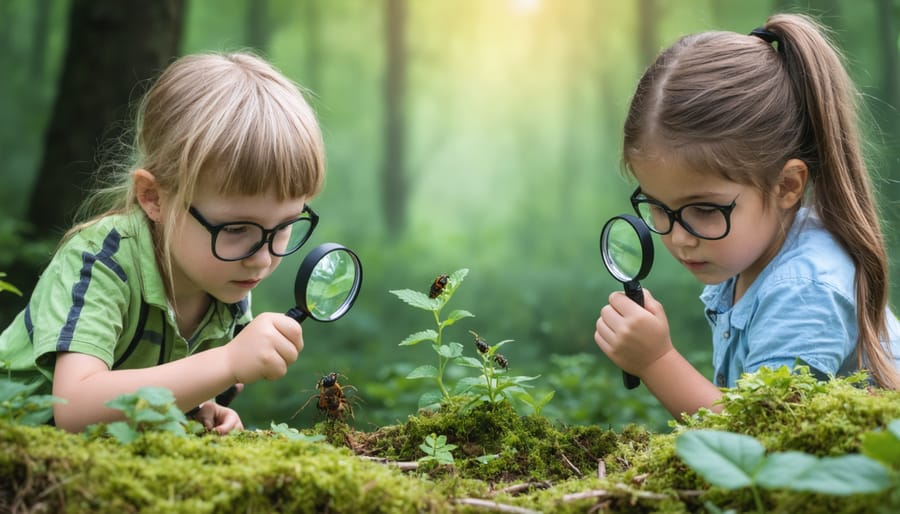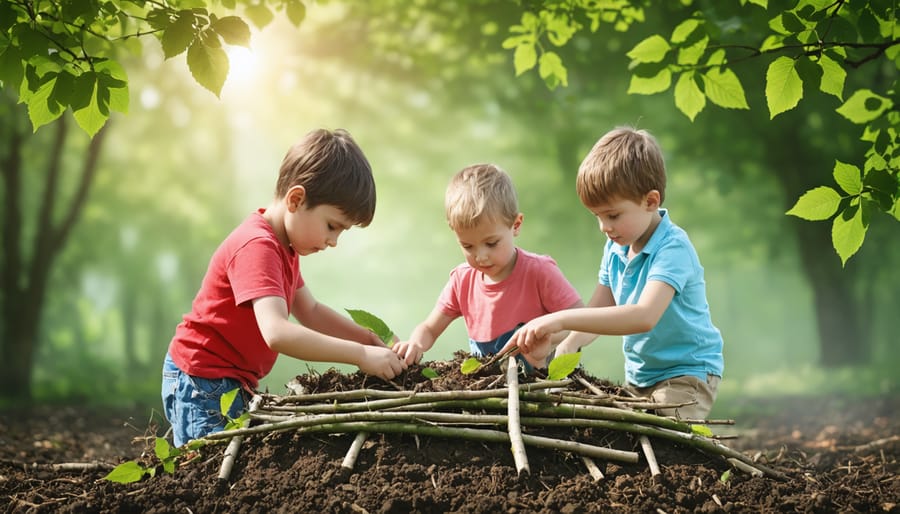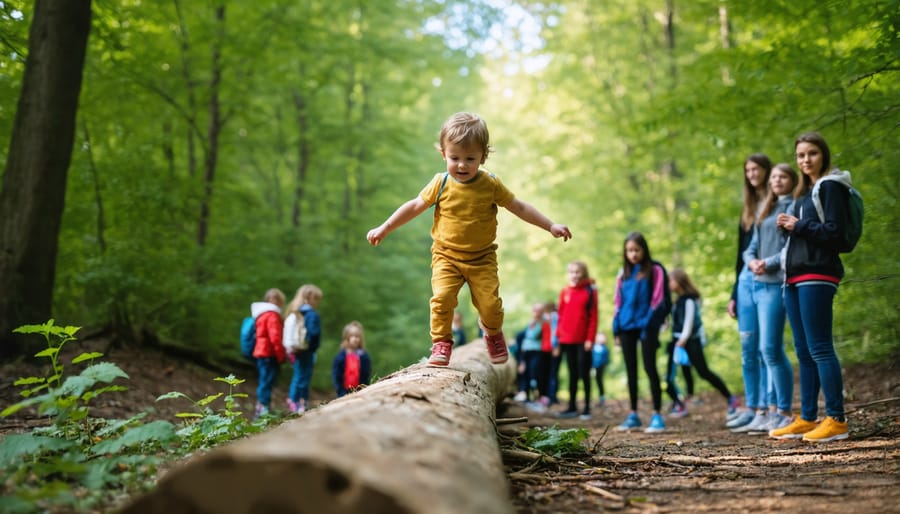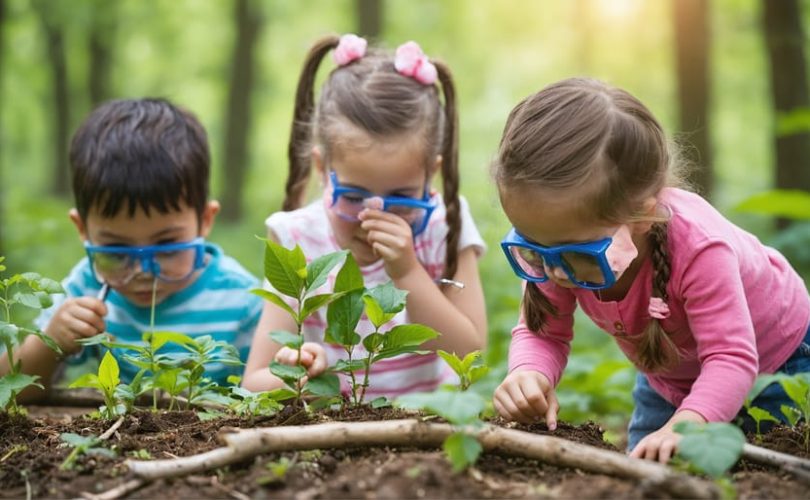Stepping outside the traditional classroom reveals a profound truth about learning: nature is our most powerful teacher. Recent studies from leading child development experts show that children who spend regular time learning in natural environments demonstrate up to 30% better academic performance across core subjects. Beyond test scores, nature-based learning cultivates essential life skills – from enhanced problem-solving abilities to improved emotional regulation and stronger social connections.
As both an educational approach and a wellness strategy, nature-based learning addresses many of the challenges facing modern children, including attention difficulties, anxiety, and disconnection from the natural world. Whether it’s conducting science experiments in a garden, practicing math through outdoor games, or simply reading beneath a tree, these authentic experiences create deeper, more meaningful learning opportunities that engage all the senses.
For parents and educators seeking evidence-based ways to enhance children’s development, nature-based learning offers a scientifically-supported path forward that nurtures both academic excellence and emotional well-being.
How Nature Nurtures Your Child’s Brain Development

Natural Problem-Solving Skills
Nature provides children with an ever-changing environment that naturally encourages problem-solving skills. Unlike structured indoor spaces where solutions are often predetermined, outdoor settings present children with authentic challenges that require creative thinking and adaptability.
When children encounter a fallen log blocking their path, they must decide whether to climb over, walk around, or find another route entirely. These natural obstacles become opportunities for developing critical thinking skills and building confidence in their decision-making abilities.
During outdoor play, children often engage in spontaneous engineering projects, like building shelters with branches or creating water channels in the sand. These hands-on experiences help them understand cause and effect relationships while developing spatial awareness and practical reasoning skills.
Dr. Sarah Thompson, a child development specialist, notes: “In nature, children learn to assess risks, test hypotheses, and develop solutions independently. These skills transfer remarkably well to academic learning and real-world situations.”
The unstructured nature of outdoor environments also encourages collaboration among children as they work together to solve challenges, whether it’s figuring out how to cross a stream or designing an outdoor fort. This natural problem-solving often happens organically, without adult intervention, allowing children to develop resilience and self-reliance.
Enhanced Focus and Attention
Research consistently shows that exposure to nature can significantly enhance children’s ability to focus and concentrate. Dr. Sarah Thompson, a child development specialist, notes that even brief periods of outdoor learning can lead to remarkable improvements in attention spans. “When children learn in natural settings, their minds become more alert and receptive to new information,” she explains.
Studies have revealed that nature-based learning can be particularly beneficial for children struggling with attention challenges. In fact, several research papers have demonstrated promising results in managing ADHD symptoms naturally through regular outdoor activities. One notable study found that children who spent just 20 minutes in a park setting showed attention improvement equivalent to the effects of common ADHD medications.
Emma Chen, a special education teacher, shares her experience: “I’ve witnessed remarkable transformations in my students when we incorporate nature into our lessons. They’re more engaged, less fidgety, and retain information better.” This enhanced focus isn’t limited to the outdoors – even having plants in the classroom or views of nature through windows can help improve concentration levels.
The natural environment provides the perfect balance of stimulation and calm, allowing children’s minds to reset and refocus without overwhelming their senses.
Social-Emotional Growth in Natural Settings

Building Confidence Through Outdoor Exploration
When children explore the natural world, they naturally encounter challenges that build their confidence and self-esteem. Whether it’s climbing a fallen tree, building a fort with branches, or identifying local birds, each successful outdoor experience adds to their sense of capability and achievement.
Dr. Sarah Thompson, a child development expert, notes that nature provides the perfect environment for graduated challenges. “Children instinctively choose activities that match their skill level,” she explains. “As they master each challenge, they become more confident to try increasingly complex tasks.”
Unlike structured indoor activities, nature offers open-ended opportunities for problem-solving and risk assessment. A child might start by stepping over small streams before gradually working up to crossing larger ones using logs or stones. This natural progression allows them to build confidence at their own pace.
Parents often report remarkable changes in their children’s demeanor after regular nature exposure. “My previously hesitant daughter now leads the way on our hiking trails,” shares Maria, a mother of two. “The transformation in her confidence has carried over into other areas of her life, including school presentations and social situations.”
Natural Stress Relief
Recent studies have shown that spending time in nature has remarkable effects on children’s stress levels and emotional well-being. When children engage with natural environments, their cortisol levels – a key stress hormone – significantly decrease, leading to a calmer and more balanced state of mind.
Dr. Sarah Thompson, a child psychologist specializing in reducing childhood anxiety, notes that just 20 minutes of outdoor activity can have the same calming effect as some traditional relaxation techniques. “Nature provides a multi-sensory experience that naturally soothes the nervous system,” she explains.
Parents and educators have reported noticeable improvements in children’s behavior after implementing regular outdoor learning sessions. Eight-year-old Jamie’s mother shares, “Since starting forest school, my son’s anxiety has decreased dramatically. He sleeps better and seems more emotionally regulated.”
The natural environment offers a gentle escape from modern-day stressors like screens, structured schedules, and academic pressures. Whether it’s listening to bird songs, feeling grass under their feet, or watching clouds drift by, these simple nature experiences help children develop healthy stress management skills that can benefit them throughout their lives.
Physical Development in Natural Environments

Motor Skills Development
Nature’s uneven terrain serves as a natural obstacle course, challenging children to develop essential motor skills in ways that manufactured playgrounds simply can’t match. When children navigate fallen logs, climb trees, or balance on rocks, they’re naturally improving their gross motor skills and spatial awareness.
Dr. Sarah Thompson, a pediatric occupational therapist, explains, “The varied textures and surfaces in nature require children to constantly adjust their movements, strengthening their core muscles and improving their balance reflexes.”
Activities like picking up small stones, examining insects, or weaving grass stems help develop fine motor skills crucial for writing and other detailed tasks. The unpredictable nature of outdoor environments also encourages children to think on their feet and adapt their movements accordingly.
Research shows that children who regularly engage in outdoor play demonstrate better coordination, stronger physical capabilities, and more refined motor skills compared to those who primarily play indoors. These natural movement experiences create a strong foundation for lifelong physical development and confidence.
Healthy Active Living
Time spent in nature encourages children to move their bodies in diverse and natural ways. Whether climbing trees, running through meadows, or balancing on logs, outdoor play provides a full-body workout that develops strength, coordination, and endurance. Unlike structured indoor exercises, nature-based physical activity feels more like play than exercise, making it more appealing and sustainable for children.
Research shows that children who regularly engage in outdoor activities tend to be more physically active overall and maintain healthier body weights. The varied terrain and natural obstacles they encounter help develop better spatial awareness and motor skills. Additionally, exposure to natural sunlight supports vitamin D production, essential for bone health and immune system function.
Parents often report that their children sleep better and show improved appetite after spending time being active outdoors. The combination of fresh air, physical movement, and natural light helps regulate their body’s natural rhythms, contributing to better overall health outcomes.
Getting Started with Nature-Based Learning
Simple Nature Activities for Home
Getting started with nature-based learning doesn’t require elaborate plans or expensive equipment. Here are some simple outdoor learning activities you can try at home today:
Create a nature observation corner in your backyard or balcony with a bird feeder and small container garden. Children can keep a daily journal of visiting birds, growing plants, and changing weather patterns.
Start a collection box for natural treasures like leaves, pine cones, and interesting rocks. Use these items for art projects, counting games, or science discussions about textures and patterns.
Plant a small herb garden in containers. Children learn responsibility through daily watering and develop sensory awareness by touching and smelling different herbs. Plus, they’ll experience the joy of using their grown herbs in family meals.
Make outdoor scavenger hunts using simple checklists with pictures for younger children or written clues for older ones. Include items like “something smooth,” “something that makes noise,” or “three different leaf shapes.”
Turn your daily walk into a learning adventure by playing “I Spy” with natural elements, counting trees, or discussing seasonal changes. Even a 15-minute nature walk can become an enriching educational experience when you engage children with thoughtful questions and observations.
Remember, consistency matters more than complexity. Regular, simple nature interactions can create lasting positive impacts on children’s development and well-being.
Finding Nature-Based Programs
Finding nature-based programs in your area is easier than you might think. Start by checking with your local parks and recreation department, which often offers guided nature walks, outdoor education programs, and seasonal activities for children of all ages.
Many nature centers and botanical gardens have dedicated children’s programs that combine outdoor exploration with structured learning activities. These facilities typically offer both drop-in sessions and regular weekly programs, making it easy to find options that fit your schedule.
Local environmental organizations and conservation groups are excellent resources for nature-based education. They frequently host family-friendly events, workshops, and volunteer opportunities that can introduce children to environmental stewardship in an engaging way.
When evaluating programs, look for those that:
– Provide age-appropriate activities
– Have qualified instructors with outdoor education experience
– Maintain appropriate adult-to-child ratios
– Include both structured learning and free exploration time
– Follow safety protocols
– Offer regular outdoor time regardless of weather
Don’t overlook schools and daycare centers that incorporate nature-based learning into their curriculum. Many educational institutions are now embracing outdoor classrooms and forest school principles. Some even offer full nature-immersion programs where children spend the majority of their day outside.
Social media and parent groups can also connect you with informal nature play groups and community initiatives that promote outdoor learning. These grassroots organizations often provide free or low-cost opportunities for children to experience nature-based education.
The evidence is clear: nature-based learning offers profound benefits for children’s physical, mental, and emotional development. From enhanced cognitive abilities and improved focus to reduced stress levels and stronger social connections, spending time learning in natural environments creates well-rounded, confident learners. By incorporating nature-based activities into our educational approaches, we’re not just teaching subjects – we’re nurturing curiosity, resilience, and environmental stewardship in the next generation.
Whether you’re a parent, educator, or caregiver, taking the first step toward nature-based learning can be as simple as moving one lesson outdoors or planning a weekly nature walk. Every moment spent learning in nature is an investment in our children’s wellbeing and future. Let’s embrace these opportunities to connect our children with the natural world and watch them flourish in ways that traditional indoor learning alone cannot provide.


